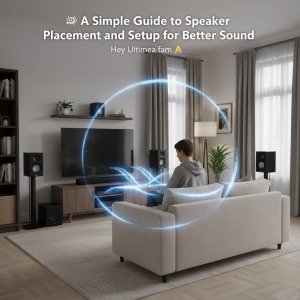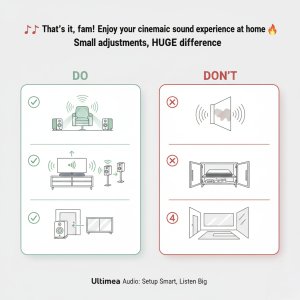Hey Ultimea fam 
I’ve seen many people (including me) curious about how much difference proper speaker placement actually makes.
So I thought - let’s break it down in a simple way. No tech jargon, just real tips that can help anyone improve their sound setup at home.

No matter what system you have - even a basic one - correct placement can completely change the experience.
If the sound doesn’t reach you from the right angles or heights, you’ll lose that “surround” feel and everything will sound flat.
A few small adjustments can make the difference between just hearing sound and feeling it.
Before setting anything up, choose your main listening spot - where you’ll sit most of the time.
Every speaker should aim toward that position.
Think of this spot as the center of your “sound bubble.”
All adjustments - height, angle, and distance - should be made keeping that point in mind.
• Keep them in front of you, around ear level when seated.
• If using a soundbar, it should be centered below your TV.
• Avoid keeping it inside a closed cabinet; it blocks sound flow.
• If it’s too low, tilt it slightly upward toward your face for better clarity.
 Tip: Make sure nothing blocks the front speakers. Even a small object can affect dialogue clarity.
Tip: Make sure nothing blocks the front speakers. Even a small object can affect dialogue clarity.
• Place it directly under or above your TV, pointing straight toward your seat.
• It handles dialogues, so placement here is super important.
• Try to keep it aligned horizontally with your left and right speakers so the sound feels balanced.
This is where most people get confused.
Rear speakers bring that immersive feel — like sound moving behind or around you.
Here’s how to set them right:
• Place them slightly behind your seating area.
• Keep them 1–2 feet above ear level.
• Angle them slightly inward, toward the listening spot.
• Don’t push them too far back into corners; it makes effects less clear.
If your room is small and you can’t go behind, place them on the sides — pointing toward your ears. That works surprisingly well too.
• If your setup includes up-firing speakers, the angle and ceiling type matter a lot.
• These should face the ceiling directly to bounce sound downward.
• Works best if your ceiling is flat and not higher than 10–12 feet.
• Avoid textured or wooden ceilings - sound reflections reduce a lot.
If your up-firing speakers are built into your soundbar, make sure it’s not placed too close to the TV stand or wall shelf top - give it some open space above.
The subwoofer gives you that deep bass punch - but if placed wrong, it can sound too boomy or too weak.
Here’s how to find a good spot:
• Keep it near a wall, but not pressed tightly into a corner.
• Corners make the bass echo and muddy.
• Try moving it a few inches forward or sideways until the bass feels clean and even.
• On tiled floors, keep a small rubber pad under it - it stops vibrations and makes the sound tighter.
If your subwoofer fires downward, make sure it’s on a solid, flat surface (not carpet).
• Hard surfaces (like tiles and bare walls) reflect sound too much. Use curtains, carpets, or cushions to balance it.
• Avoid putting large furniture or glass right between the speakers and you.
• Closed rooms sound tighter, while open rooms can lose bass. Adjust accordingly.
Once your setup is done, play a few familiar tracks or movie scenes - ones you know well.
Listen carefully:
• Dialogues should sound centered.
• Background sounds should move naturally around you.
• Bass should feel deep but not overpowering.
If something feels off, adjust the angle or distance slightly. Small changes make big improvements.
You don’t need expensive meters or pro tools to get perfect sound. A bit of patience and trial-and-error can make even a basic setup feel premium.
Someday, I’d love to test all this again with a full Ultimea laser audio setup - that would be a dream experience for sure

That’s it, folks! Hope this little guide helps anyone struggling with placement or sound clarity.
If you’ve tried your own tricks or setups, share them too - everyone learns together that way
Harsh Jain

I’ve seen many people (including me) curious about how much difference proper speaker placement actually makes.
So I thought - let’s break it down in a simple way. No tech jargon, just real tips that can help anyone improve their sound setup at home.

1. Why Speaker Placement Matters
No matter what system you have - even a basic one - correct placement can completely change the experience.
If the sound doesn’t reach you from the right angles or heights, you’ll lose that “surround” feel and everything will sound flat.
A few small adjustments can make the difference between just hearing sound and feeling it.
2. Start With Your Listening Position
Before setting anything up, choose your main listening spot - where you’ll sit most of the time.
Every speaker should aim toward that position.
Think of this spot as the center of your “sound bubble.”
All adjustments - height, angle, and distance - should be made keeping that point in mind.
3. Front Speakers / Soundbar
• Keep them in front of you, around ear level when seated.
• If using a soundbar, it should be centered below your TV.
• Avoid keeping it inside a closed cabinet; it blocks sound flow.
• If it’s too low, tilt it slightly upward toward your face for better clarity.
4. Center Channel Speaker (if you have one)
• Place it directly under or above your TV, pointing straight toward your seat.
• It handles dialogues, so placement here is super important.
• Try to keep it aligned horizontally with your left and right speakers so the sound feels balanced.
5. Surround / Rear Speakers
This is where most people get confused.
Rear speakers bring that immersive feel — like sound moving behind or around you.
Here’s how to set them right:
• Place them slightly behind your seating area.
• Keep them 1–2 feet above ear level.
• Angle them slightly inward, toward the listening spot.
• Don’t push them too far back into corners; it makes effects less clear.
If your room is small and you can’t go behind, place them on the sides — pointing toward your ears. That works surprisingly well too.
6. Up-Firing / Dolby Atmos Speakers
• If your setup includes up-firing speakers, the angle and ceiling type matter a lot.
• These should face the ceiling directly to bounce sound downward.
• Works best if your ceiling is flat and not higher than 10–12 feet.
• Avoid textured or wooden ceilings - sound reflections reduce a lot.
If your up-firing speakers are built into your soundbar, make sure it’s not placed too close to the TV stand or wall shelf top - give it some open space above.
7. Subwoofer Placement
The subwoofer gives you that deep bass punch - but if placed wrong, it can sound too boomy or too weak.
Here’s how to find a good spot:
• Keep it near a wall, but not pressed tightly into a corner.
• Corners make the bass echo and muddy.
• Try moving it a few inches forward or sideways until the bass feels clean and even.
• On tiled floors, keep a small rubber pad under it - it stops vibrations and makes the sound tighter.
If your subwoofer fires downward, make sure it’s on a solid, flat surface (not carpet).
8. Room and Environment Tips
• Hard surfaces (like tiles and bare walls) reflect sound too much. Use curtains, carpets, or cushions to balance it.
• Avoid putting large furniture or glass right between the speakers and you.
• Closed rooms sound tighter, while open rooms can lose bass. Adjust accordingly.
9. Fine-Tuning and Testing
Once your setup is done, play a few familiar tracks or movie scenes - ones you know well.
Listen carefully:
• Dialogues should sound centered.
• Background sounds should move naturally around you.
• Bass should feel deep but not overpowering.
If something feels off, adjust the angle or distance slightly. Small changes make big improvements.
10. Final Thoughts
You don’t need expensive meters or pro tools to get perfect sound. A bit of patience and trial-and-error can make even a basic setup feel premium.
Someday, I’d love to test all this again with a full Ultimea laser audio setup - that would be a dream experience for sure

That’s it, folks! Hope this little guide helps anyone struggling with placement or sound clarity.
If you’ve tried your own tricks or setups, share them too - everyone learns together that way
Harsh Jain
